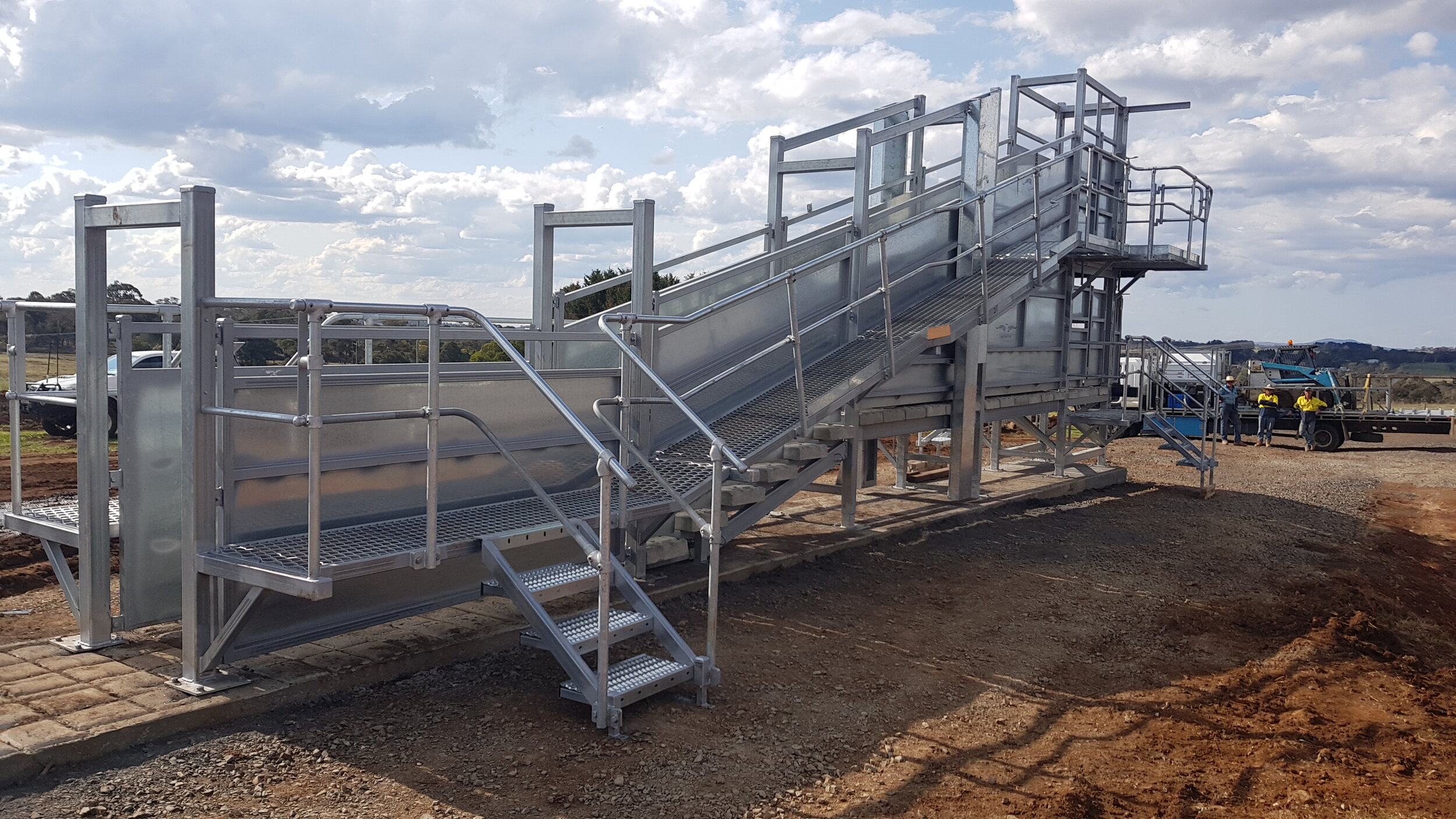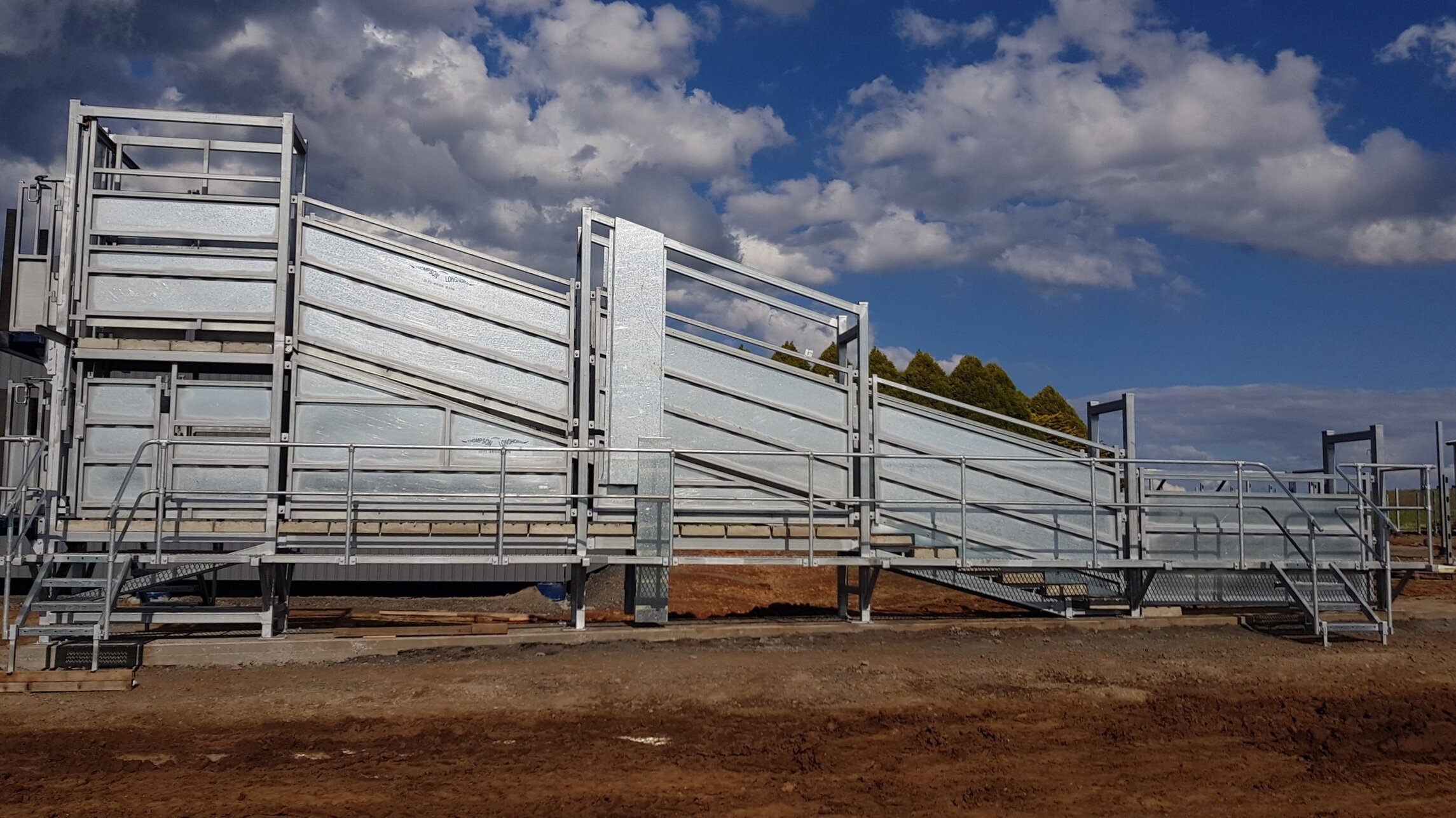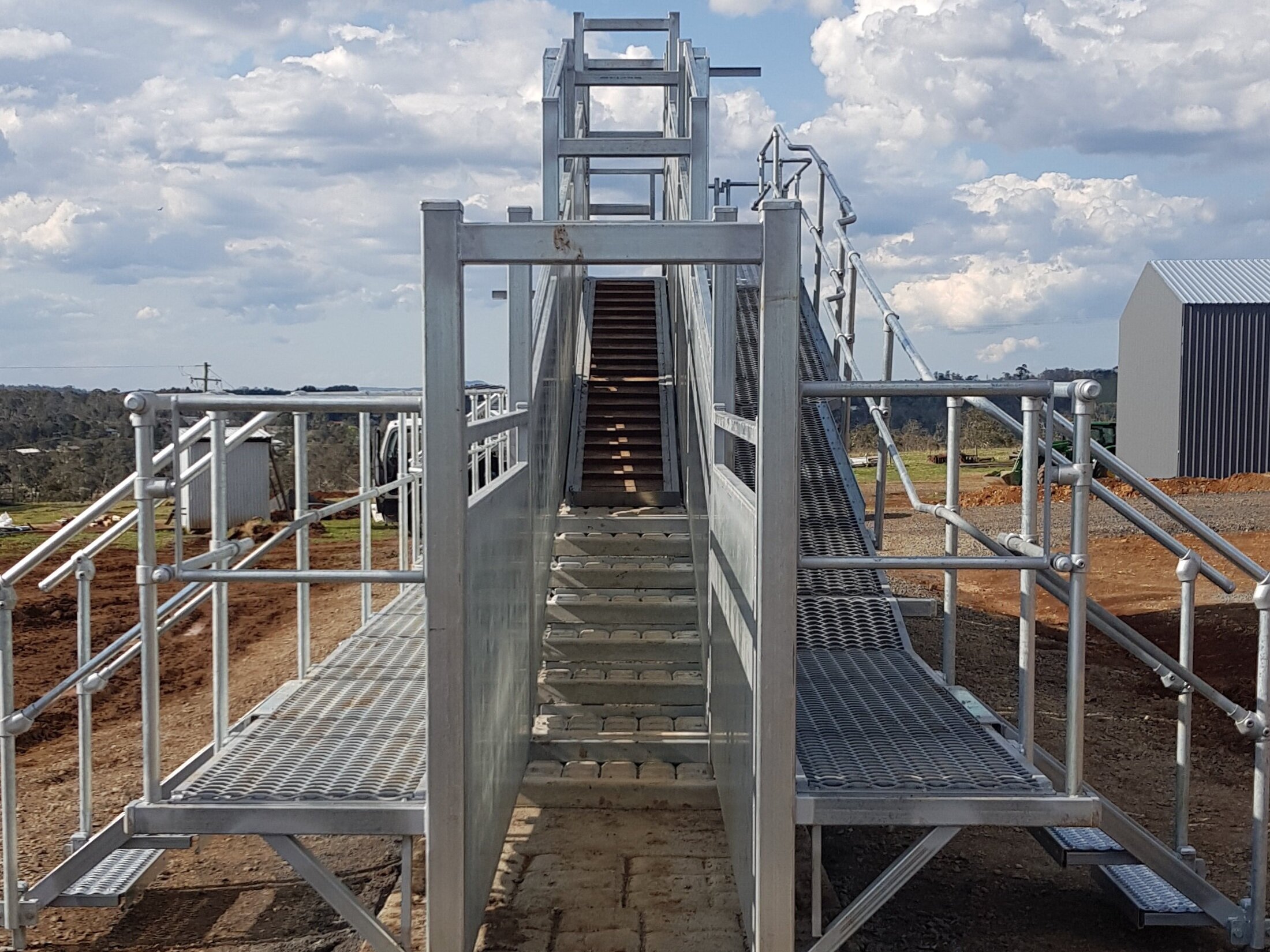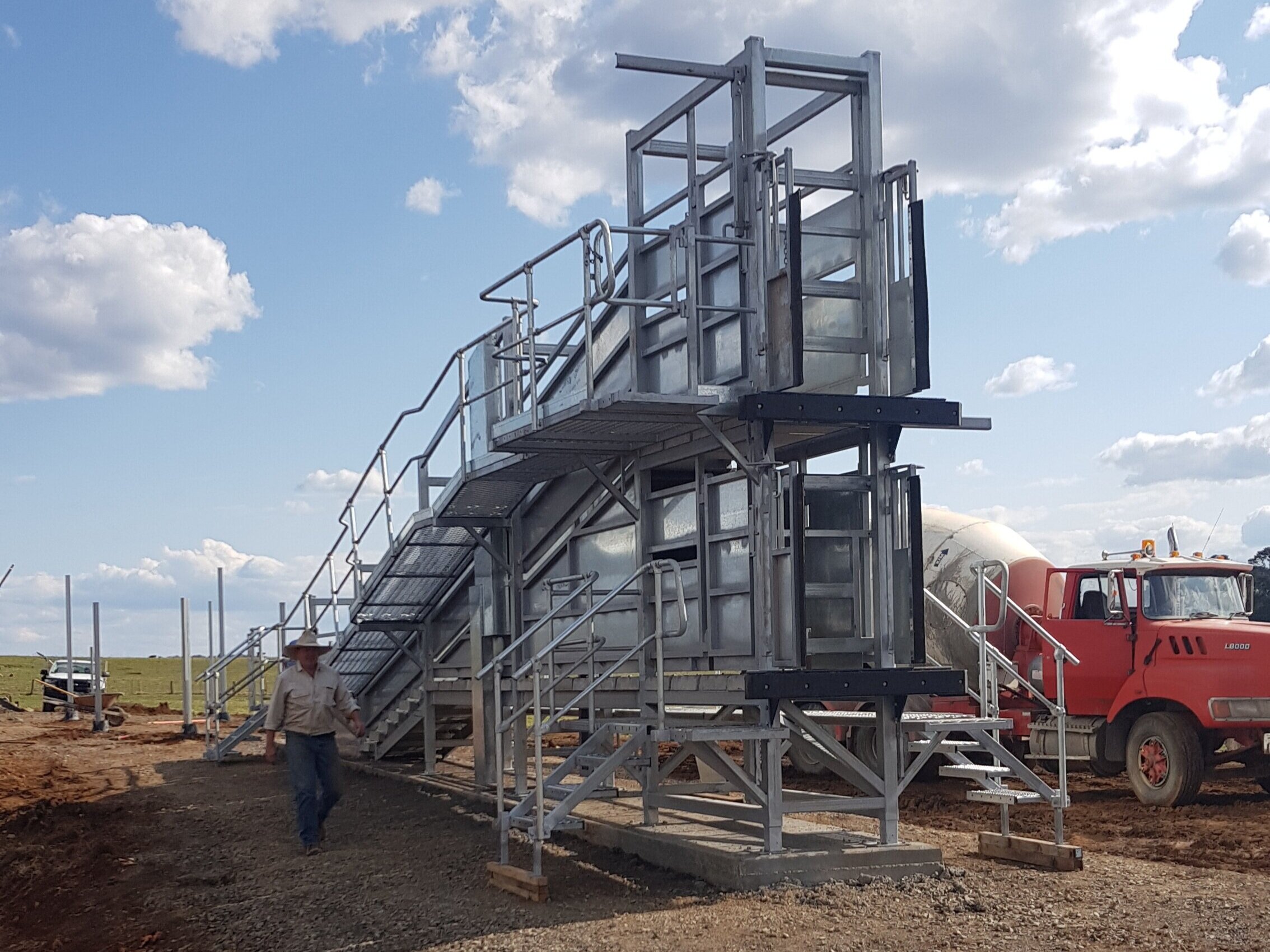Double Deck Single Lane Loading Ramp
Double Deck Single Lane Loading Ramp
Features:
Modular construction using pre-fabricated components
Pre-cast concrete steps with traction grooves
Suitable for side and rear loading
Various batwing, front bumper and catwalk options
Lockable sliding gates at ramp front
Fixed fronts with HDPE plastic bumper
Hinged batwing gates
Heavy pre-gal frame: 2mm galvanised sheet
Hot dipped galavanised footings
Walkway
Description:
This loading ramp has been designed to suit a primary producer trading at a high stocking rate or a small commercial enterprise as the compatibility with double deck loading gives the option to increase load out size compared to just operating with a single deck ramp.
The ramp operates normally as a single deck loading ramp, while a adjustable ramp in suspended above and can be lowered into place when the operator wants to load cattle into the top deck of a transport truck. This is done by using a weight system which control the suspension level of the ramp, to lower the ramp a safety pin is removed and the weight suspension is decreased until the edge of the ramp reaches the floor of the bottom level. The ramp is hinged from a fixed point one panel in from the end on the ramp, this helps cattle when they are loading from the adjustable ramp as it gives them room to adjust and smoothly walk onto the truck. The ramp itself is roughly 5 meters long, slightly less than two 3 meter panels. The ramp was made at this length as the gradient when using is optimal for cattle to walk up and down, it is also a continuing gradient from the concrete steeps which approach from the lower level of the single deck ramp.




Introduction
A loading ramp is a unit that is used for the loading and unloading of cattle from trucks. It is an important item as nearly every cattle handling stockyard has one and sale yards have many. Typically the loading ramp is used to elevate cattle to the height of the trailer. Stockyard design can start from the available loading ramp positions due to truck access and type of trucks intended to be used. When starting to construct a stockyard, the mark out datum locations and rotation can be driven by the loading ramp.
Ramp or Dock
A loading dock has the appropriate step in ground level so the trailer is the right height with the yard’s ground level. A dock is only used if the land terrain suits. The site needs to have a natural step of slope so the dock can be back filled. A dock also reduces the need for catwalks when loading only single decks. However most loading and unloading is done using a ramp.
Loading methods
A loading ramp can be used two ways to either back load or side load a trailer. Commonly larger trailers have either function others always have rear loading. For rear loading adequate distance in front of the ramp is required for the truck to turn and back. For side loading it is important that the truck path clears any fences, is straight when it reaches the ramp and any turning radius are not too sharp.
Cattle Loading Ramp Styles
There are several styles of ramp. These are single deck, double deck, and a dump.
The single deck is the most common as even double deck trailers can still be loaded and unloaded from these. For larger operations were a large amount of loading and unloading is done a double deck ramp is considered. These reduce loading and unloading time by not having to use the internal ramp of a double deck trailer. Also by alternating groups of cattle between the top and bottom decks both they can be both loaded simultaneously.
Typically a loading ramp is narrow like a race so cattle will load in single file and prevent turning back. However this isn’t the case when unloading and a dump ramp can be used which is much wider. The dump helps reduce unloading time and is normally constructed alongside a narrower loading ramp sharing a common fence.
Cattle Loading Ramp Sheeting & Catwalk
The large commercial loading ramps are fully sheeted to improve cattle flow, the sheeting preventing baulking from visual distractions. Catwalk is added alongside the ramp to elevate the operator to the right height if coaxing is required. For a single loading ramp a catwalk both sides is an option. Access for the truck driver’s side also needs to be considered for opening and closing both rear and baffle trailer gates.
Slide gates
Other design considerations are sliding/stop gates and front type. Slide gates can be either located at the top or bottom of the ramp. For a double ramp they are best located at the top. For a dump ramp a gate is used at the bottom as it is too wide for a slide gate. Lockable gates needs to be considered to prevent illegal or unauthorized stock removals or quarantine measures. Fronts on ramp which are used with rear loading trailers need to consider some buffering. For fixed fronts timber or docking rubber is used, however a spring loaded, pivotal front is another alternative.
Cattle Loading Ramp Floor
At Thompson Longhorn single and double loading ramps use concrete steps to ramp. This offers better anti-slipping as they are grooved and overcome corrosion or rot problems compared to other timber or steel floored ramps. However, for the wider dump ramp the best floor is a concrete base poured on site prior to construction of the rest of the ramp. This would include the personnel access path on the outside.
Summary:
Main purpose is for loading and unloading trucks
Commonly ramps but a step in ground level is a loading dock
Can be used to either rear load or side load trailers
There are single, double and dump type ramps
Commercial ramps are fully sheeted with catwalks
Catwalks have handrails for OH&S and Australian Standards
Consider access for truck drivers
Lockable slide gates to prevent illegal/ unauthorized cattle removal or quarantine measures
Buffered front or spring loaded pivotal front for rear loading trucks
Use concrete stepped floors for better grip and corrosion or rot properties
Features:
Heavy duty frame construction
Hot dipped galvanized feet, good for highly corrosive environments
Adjustable feet can take variations in slab height. Units need to be plumb for optimal operation of all gates
Feet bolted to concrete allowing for removal and locating during installation (after concrete slab is poured)






